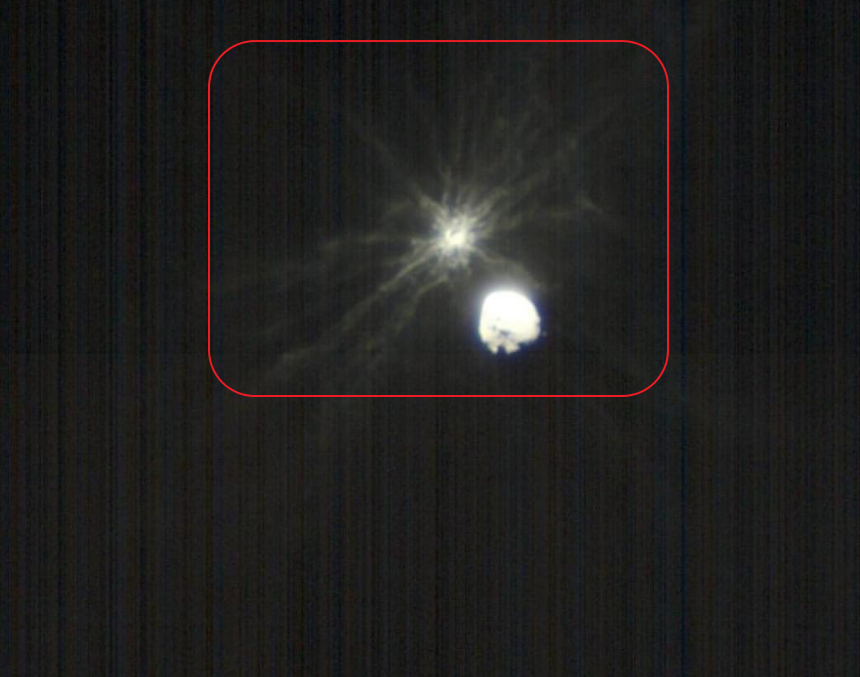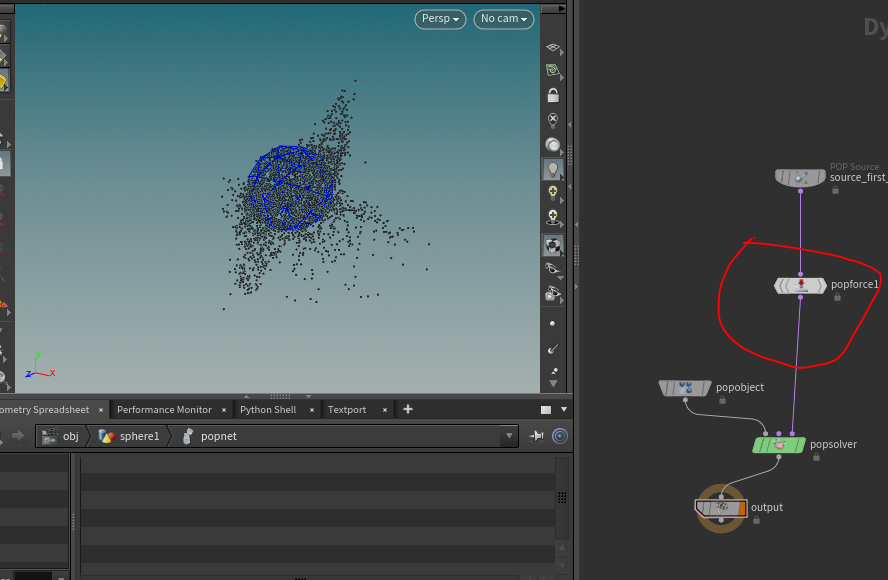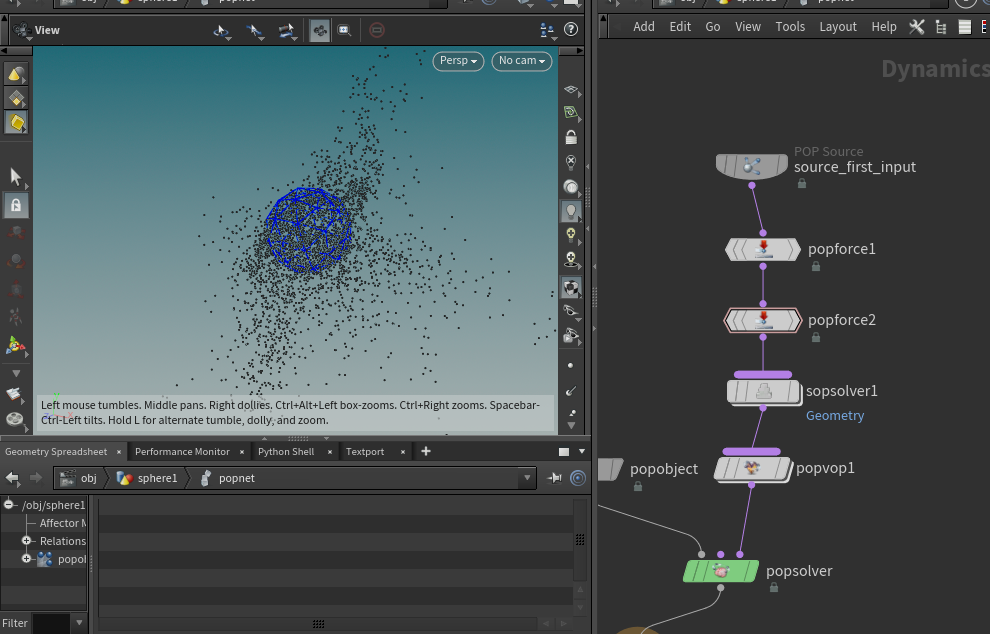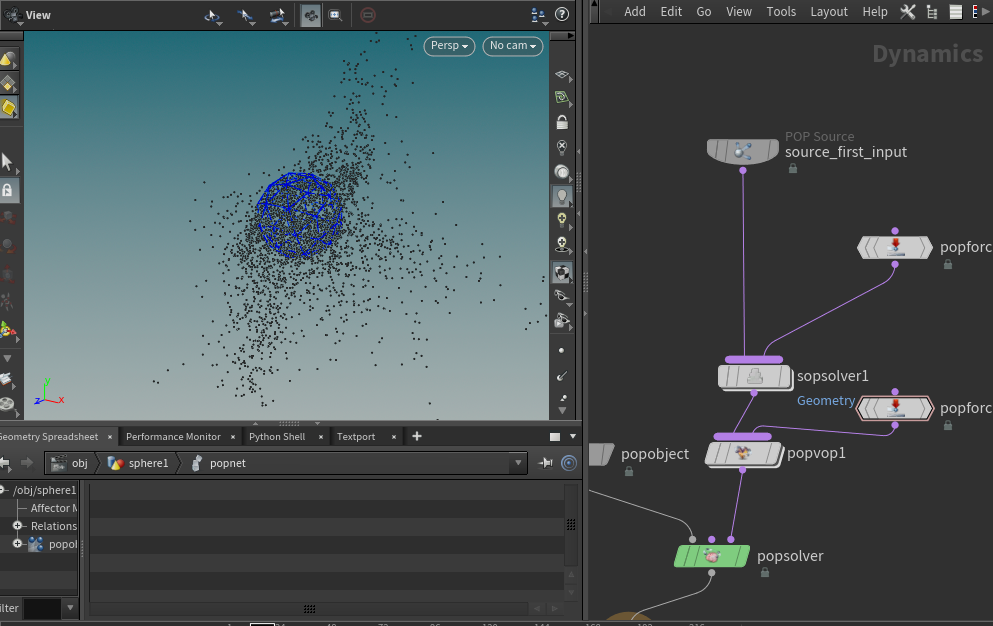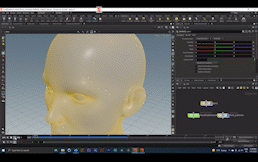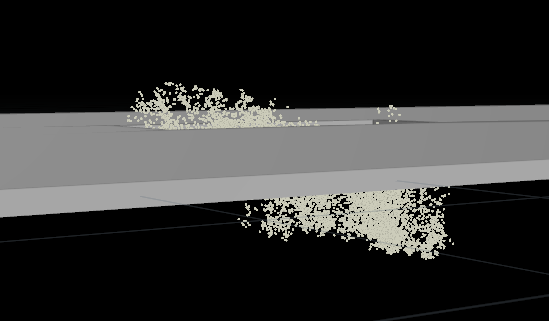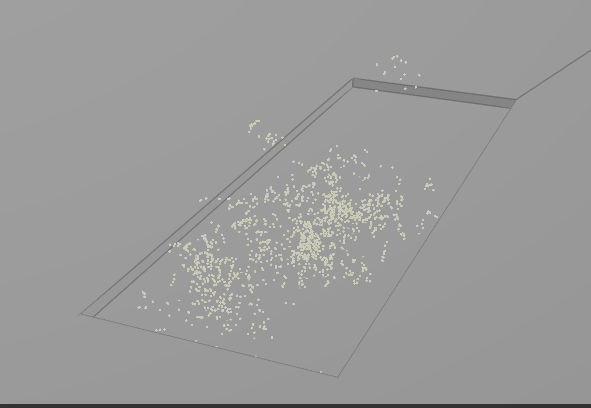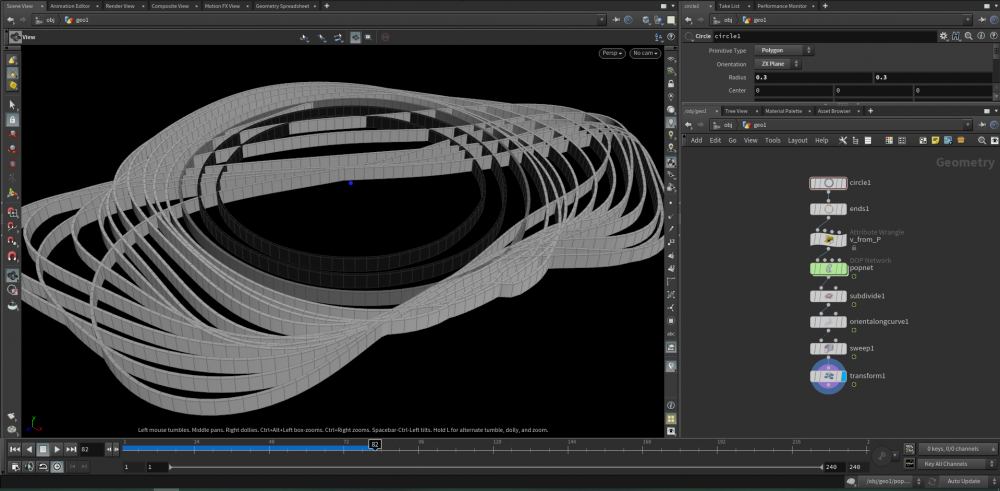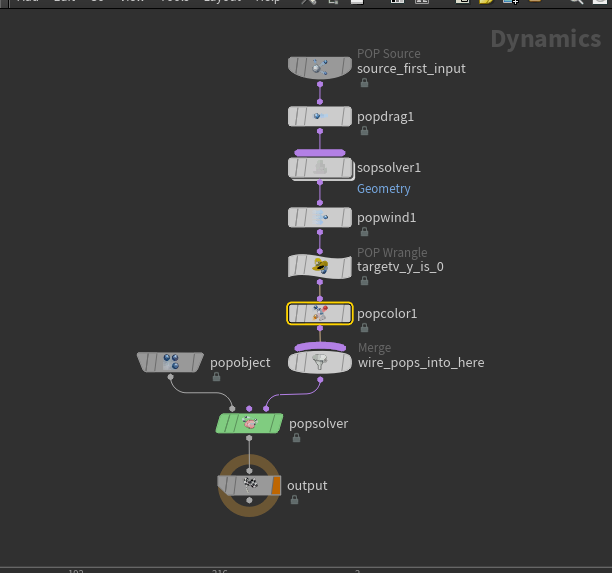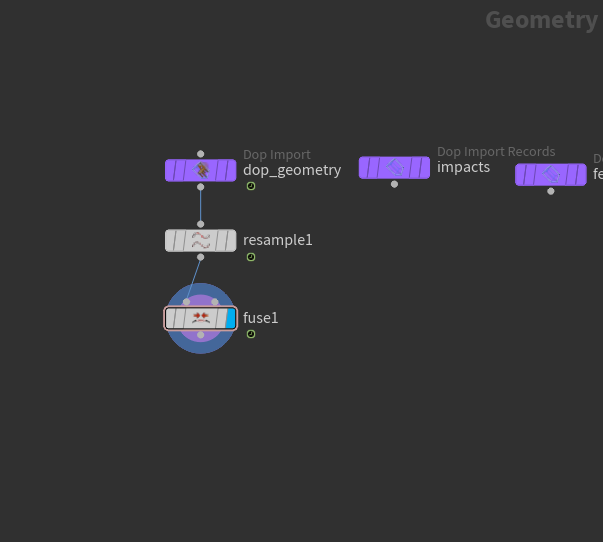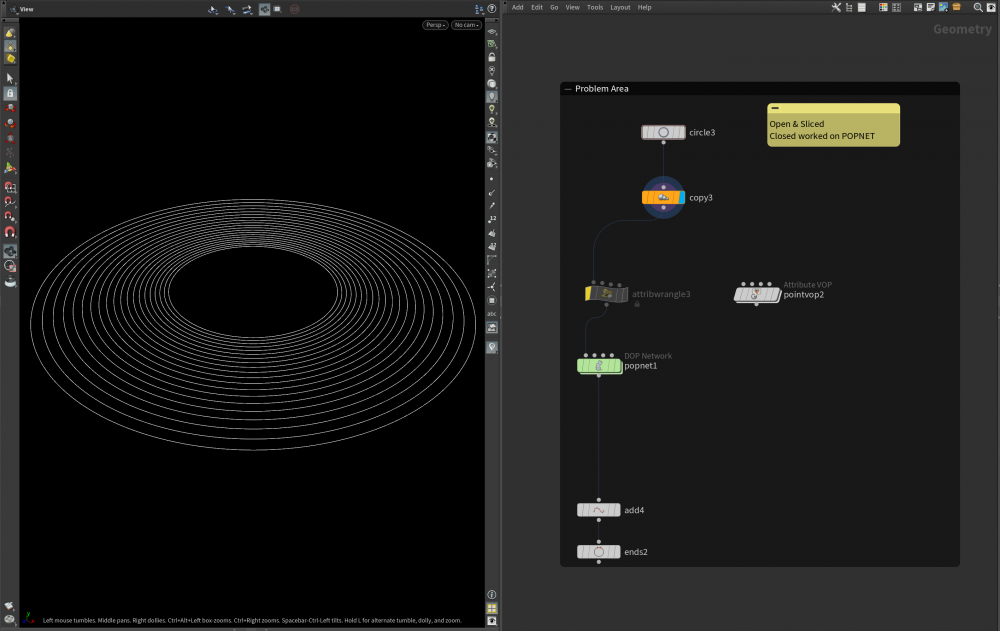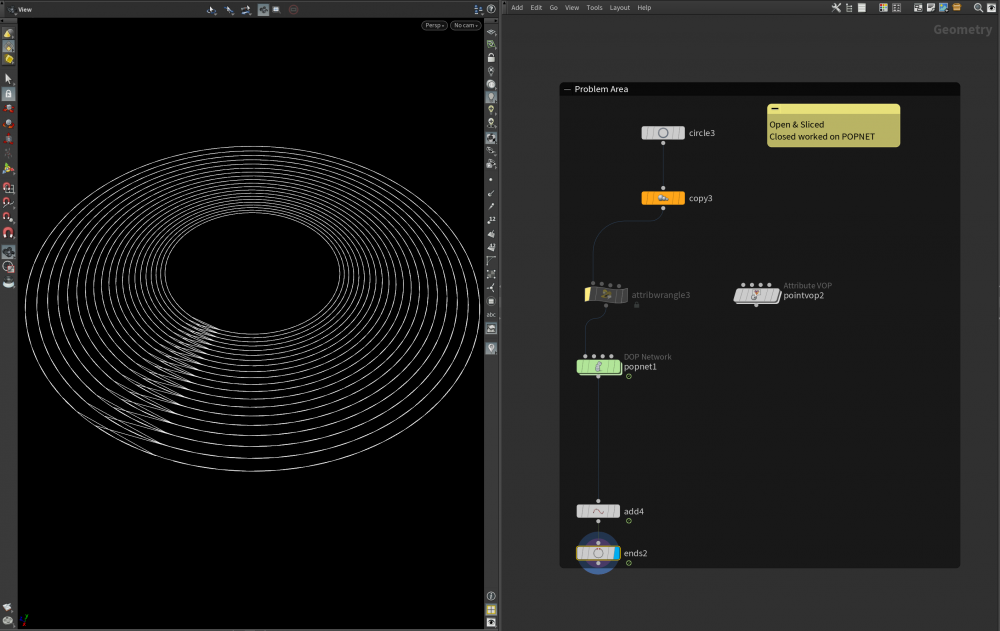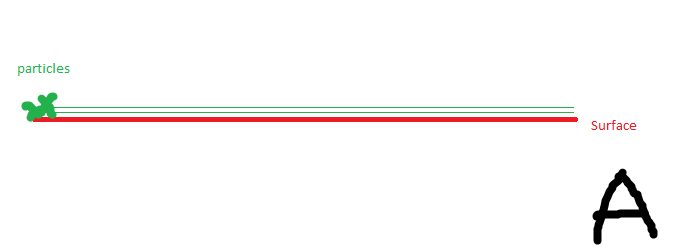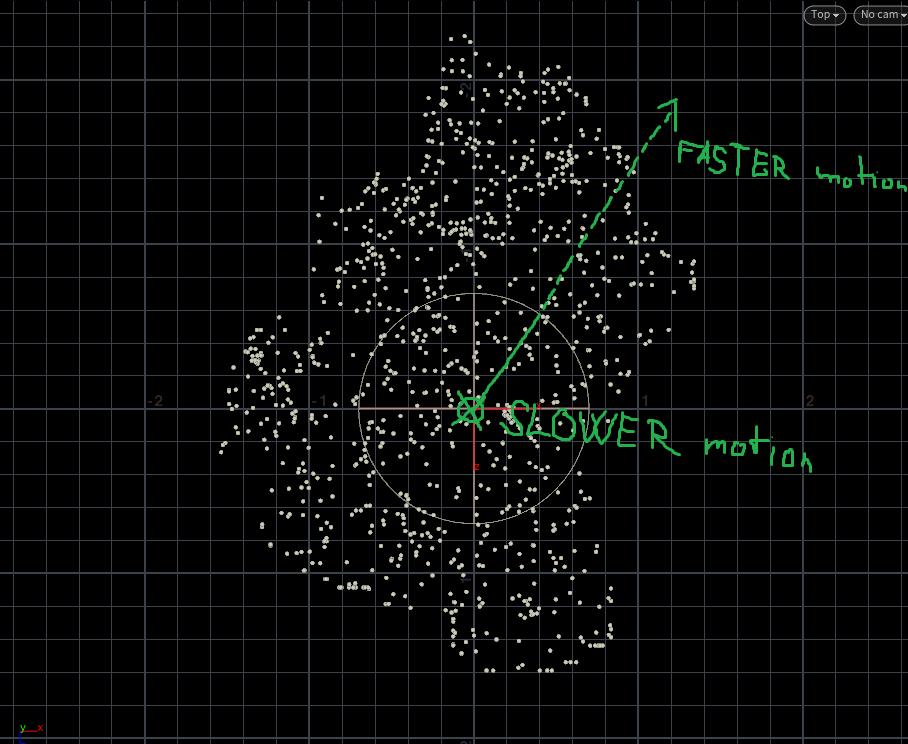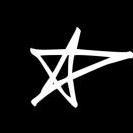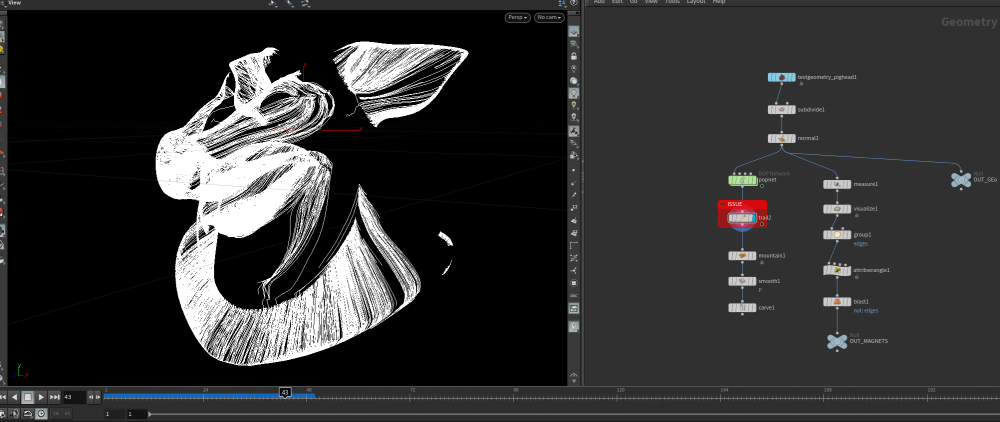Search the Community
Showing results for tags 'popnet'.
-
Hello folks, I have a picture from the recent DART satellite impact from NASA (see below). I wonder, if there is a way to recreate this impact-streaks-effect in Houdini. What I already tried: - created a particles simulation (tried to drive a smoke sim on those particles, then use this pyro sim to drive the same particle sim ontop of it - by using the node: "pop advect by volumes") - created jittered lines form a sphere, but here I am stuck on transfering the velocity attribute to the particles, so that they should move along these jittered lines =========================================================================================================================================== Now I am asking this forum to help me recreating this type of effect. How would you do that? Please only explained answers - short answers are useless! so, I would appreciate if you take your time to answer this question. Thanks in Advance
-
Hi, I have a basic question about connection in popnet. There are 2 ways to connect nodes, parallel or serial connections, and I wonder how exactly these methods are different each other and how we decide to choose them. Obviously when we use multi pop_source nodes, we have to use a merge node. On the other hands, do we have any other specific situations we have to or should not use merge nodes?? popvop and sopsolver nodes also have multi input options as well, which I guess the same deal. If someone demonstrate how we decide to choose parallel or serial connections, it would be great. My guess is that if we use only ONE pop_source node, parallel or serial does not matter. However, if we use multi pop_source nodes, it should be important. The force/velocity operation nodes would not matter how they are connected as screen capture's sim results. Do they make sense?
-
Hey, I need some help doing blood drips sim from the forehead of a model. I've been trying out the CONDENSATION SHELF tool and this was the closest result i could get to what I want. Here is the Issue. 1) I'm wondering if this is the best way to do it (idk if FLIP is better for this). 2) I've not been able to fix the gaps between the particles so they leave a trail and don't look like just chunks (I think taht one is about smaller particle separation). 3) I want the drips to start from left of the models forehead to right. I've been tweaking it for a week and just made it worst this is the best result i could get. Thanks to everyone that has ever answered something on odforce everything has been so helpful. BLOOD_HEAD_DRIPS_v04.abc
-
Why static object is not working in popnet
Ansh Kathuria posted a topic in General Houdini Questions
Hey there! Please anyone help me with this, When i make the Static object node in the "popnet", then the particles i created does'nt collide with that ground or static object. I tried many ways but the collision is not happening with the particles and static object. Here i have a ground which is subtracted(By boolean) from the main ground which is being fractured and the main ground is emitting debris, but whenever i use static object and import the ground to be a static object there, it won't collide with particles. Why is this happening and what is the best solution for this ? Here i linked 2 images where you may understand what i am trying to say. Anyone's help will be appreciated, Thanks in advance.- 8 replies
-
- static object
- popnet
-
(and 2 more)
Tagged with:
-
I'm currently working on a POP netowork to simulate raindrops on a window, and am trying to isolate the original particles from which the trails (in red) are emitted as per an emit attribute using the POP replicate node, so that I can selecting apply a POP interact force to them. However, I'm really struggling to find a way to isolate those points. I couldnt find any reference to the original points within the POP replicate node, apart from the fact that their ID is added to the sourceptnum attribute. Am I missing an obvious solution? Thanks
-
Hello, I have scene where I am emitting rings from the center of the world with a pop network, and a sop solver inside. The problem is that they don't collide within one another. I am a beginner so I am not sure where to go from here. All the progress I have is with the help of tutorials and help from the forums. Scene: Pop net: Sop Solver: ring emitter.hip
-
Hello everyone! The guys need help how to slow down or stop a particle based on its age. That is, the more her age. the slower she moved and then stopped altogether deceleration.hip
-
Hi. I am currently working on an effect for tracer bullets on a fighter plane and I was wondering if there is any way to make the emission more controllable? Currently in my popnet I have 2 pop sources, one with probabilistic emission which creates a random emission pattern and one with it off so it emits particles at a constant speed. I have a switch setup so I can animate which emission method is used, but its either one or the other. I would like to be able to mix these 2 pop sources together so I could have a constant emission with added randomness created from the probabilistic source. ex: (20% of probabilistic, 80% constant or vice versa) Thanks hip file: machinegunfire_fx_ODforce_v012.hipnc
-
Hello, guys. I am a newbie into Houdini, I am currently working on a personal project, the purpose is to acquire new skills throughout whole process. I was trying to copy a Circle Spline laid on ZX Plane, and base on its Scale Variation (Parameter set to Scale[1.05, 1.05, 1.05]), So copies will expand continuously on ZX Plane as Copy SOP total number increases. Then I wire into Popnet, trying to advect the Circle Splines by Pyro Sim. After Popnet I was trying to use Add SOP to connect all point and reestablishing its original look. (Tried both All Points and Group by Attribute) And it ended up wired looking connection, I even tried to use End SOP to close Polylines, but it doesn't work. Is anyone being kind to help me out? Thank you. I will attach screenshots and scene file. Stay Safe, Stay Healthy. Jaala Hsu PyroSim Advection.hipnc
-
Hi, So I was fiddeling with the popnet and finally got a nice stream of particles, but it doesnt render. It's in the viewport. But it does not render. What I have are several lines that are used for creating geometry. all these lines are in one geoSOP. I want to use the a single line as a source for popnets for my particles. Also for all other lines. So I created a subnet for this so it can be copied and paste. So everything in in one geosop. Now for some reason the particles only show up in my viewport, but the particles does not show up as spherers in the render. Therefore I made a little test and created an empty geosop on obj level with a popnet. This time the render does show the particles as spheres. So, what exactly is the right workflow for particle effects, so that I can render them. And what is wrong with my first approach. Hope you can help out. Thanks in advance, M
-
Hi forum! Seeking out some help here, cos I can't get my head around generating vellum geometry. I am working on a scene where I need to create close-up splashing water droplets on a static surface. Typically this would probably be a FLIP task but it seems like overkill and I am only after a couple of droplets, so the idea is to make rain and splashes with particles, copy some spheres on them and feed them to vellum to get some nice softbodies, then VDB them. My problem is I don't understand how I can "emit" on my source points that come to existence arbitrarily (ie. not on frame 1) and differentiate the newly created vellum patches. I've looked around, watched the masterclasses, I understand it has to be somehow parallel to constraint creation, maintain point count/id etc, but I cant figure out the solution. Its gonna be a single splash so continuous emission (as in a particle emitter per se) doesn't work for me. Any pointers are appreciated, check the hip for a rough sketch of the problem! Thanks in advance! od_vellum_splash.hip
-
Hello Houdini Magicians, This little bit of code is, according to the performance monitor and some debugging, slowing down my simulation... alot. Specially with a high number of particles. The nPt comes from the nearpoint function. I analyzed the performance impact of the nearpoint function with many particles and it is not significant. Its the conditions and moving/removing particles from groups. What is the optimal way to do this?
- 2 replies
-
- popwrangle
- popnet
-
(and 5 more)
Tagged with:
-
Hi houdini nation! Can I have any advice? Im trying to make animation of 5 testing geometries which are coliding between them selves. The position and rotation is defined by popnet, but when I connect it with vellumcloth, it doesnt use any animation data, even if I set Match animation in vellumCloth node. Can u help me pleas fix this issue? Thank u so much for any advices. issue.hip
-
Hi All, I'm trying to get this setup working where I have particles that are being activated and turned on before being fed into a pop net. I'm stuck as to how i might be able to birth only each initial particle as they're activated into the popnet. I'm trying a couple of expressions in the impulse activations, but not having luck. I'm currently birthing particles at a constant rate every 5 frames, but what I would like to do is only birth once on each incoming particle. Any help would be appreciated as I'm still learning this Particle_Growth_example.hiplc
-
Hello Houdini guys! Can I Ask you for any advices in case of my issue? I would like to know how can I get same (or similar) result as down here in the scheme. (I am also attaching my simplyfied hip. file) I would like to force particles to the surface, but not let them just slide on that surface. Hope you understand what I mean. I will be very grateful for any advices. Thnak You guys. A: is how the script works now B: is how it should works issue.hipnc
-
Hello houdini masters! I have small issue, in popnet. Im trying to create moving particles on plane, but with different "speed" U can see my intention on scheme down here. Can u guys please help me? I will be very grateful for any advices. Thank u very much!! particles_issue.hip
-
Here is a small test setup I've made. It is advecting particles along a curve, driven by a velocity field. I added another velocity field pushing the particles back towards the centre of the curve and blended the two. This is done by deriving a new field, based on a volume gradient and multiplying the volume gradient by the volume sample and negating it. So far, I haven't tested it much, but it seems like it is working, but the settings will certainly need some tweaking. As in Houdini, there are very often multiple solutions to the same problem, I was wondering if there was a different way of achieving this...how would you do it or improve it? advectPush.hipnc
-
Hello people, im trying to make a poly-line from series of points. Everything works perfect (picture_1) BUT every time when the simulation reaches frame 44 the lines close its rows, (picture_2) and I dont know why. Can U help me please fix this issue? Thanks a lot! ISSUE.hip
-
Hi, In my popnet, I want that, a new particle is born only if there are no particles in the scene. That is, suppose a single particle is born and dies after, say some random frame, only then a new particle is born. No new particle can be born even if a single particle is alive. How can I do that? Please help Thanks @Alain2131 : Sorry to tag you here, I just wanted some more help. Please let me know if tagging is not permitted or if you are bothered by it, I wont tag you again.
-
Hi, I'm Kind of new into this Houdini world and is not an easy world, but I like it, I got this problem: I want to make a fracture with debris, but I want that my debris wit its own geometry, So I searched, and what I understood was this: In the picture the null(out_dust) is the geometry that I want for my debris, and blast 3 is just the popnet but without a floor , when i watch the copy node is working but not correctly, the debris have the geometry that i want but the simulation is wrong, I made an example using poplocation and it works just fine, I don't know if the problem here is beacuse im working with a popsource, any kind of help will be really appreciated. ps: sorry for my english.
-
Hello, I have a popnet with that emits one particle every 10 frames and I need to increase substeps to get more accurate result...however when I increase substeps it affects pop source and emits more particles. For example if I have 3 substeps, it will emit 3 particles instead of one. I've tried using gasintermittentsolve but when using that it just won't emit anything at all unless frames between solves is set to 1. Is there any other workaround for this? Thanks
-
Hey everyone! I've been digging through the forum but quite haven't found something that will help me get this effect i'm trying to achieve. i'm trying to work on an setup where I have particles stuck on a deforming grid and the particles become unstuck as they inherit velocity in Y(sop solver) and then with gravity they come back down. my current setup might be too complicated because it's proving very difficult to control. i am using a popnet where particles stick to the collider geo and become unstuck with a sopsolver "if (@Cd.r > .1){ @stuck = 0; }" does anyone have ideas on how to simplify the setup? is this something that the grain solver would be better at handling? thanks everyone! waveRipple_v003.hip
-
Hi, I have created a particle system using popnet.My emitter type is location. There is a sphere in the way of moving particles. I need to add a new velocity from the normals of sphere, to the existing velocity of particles. I tried using attribute transfer. It adds velocity, but only in data, visually particles don't seem to be changing velocity. They just go in a direction, as started from location emitter. Any solution would be helpful.

